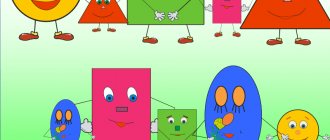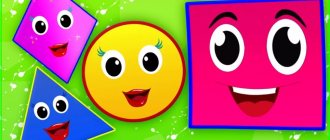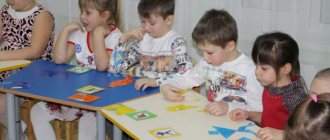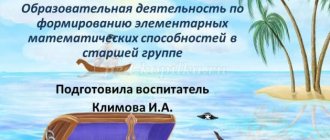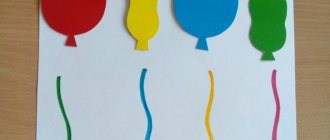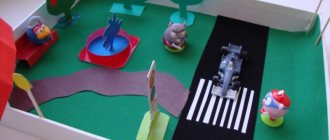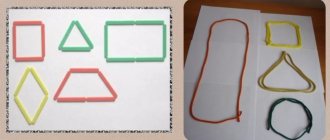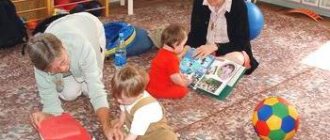3.2. Methods and techniques for forming elementary mathematical representations
3.2.
Methods and techniques for forming elementary mathematical representations
Method
(Greek
metodos
- literally “path to something”), a way to achieve a goal.
Teaching methods
– methods of interrelated activities of teachers and students aimed at achieving the goals of education, upbringing and development of schoolchildren (Babansky Yu.K.).
Currently, there are several different classifications of didactic methods in pedagogy.
One of the first was classification, which was dominated by verbal methods. Ya. A. Komensky, along with verbal ones, began to spread another method based on acquiring information not from words, but “from the ground, from oaks and beeches,” that is, through knowledge of the objects themselves.
At the beginning of the 20th century. the classification of methods was mainly carried out according to the source of knowledge - these were verbal, visual, practical methods.
During the formation of preschool education, the development of methods for the formation of elementary mathematical concepts was influenced by methods of teaching mathematics in elementary school. The monographic method of A.V. Grube and the computational method (method of studying actions) penetrated into the practice of kindergartens. E.I. Tikheeva and F.N. Bleher introduced the game as a teaching method. Since the 50s. Practical methods are increasingly used in teaching children (A. M. Leushina).
At the present stage, various teaching methods
:
- practical,
- visual,
- verbal,
- gaming
When choosing methods, a number of factors are taken into account:
- goals, objectives;
- content of FEMP at this stage;
- age and individual characteristics of children;
- the teacher’s personal attitude to certain methods;
- specific conditions in which the educational process takes place;
- availability of necessary teaching aids, etc.
The most rational is a combination of various methods.
The leading method is considered to be the practical one. Its essence lies in organizing the practical activities of children, aimed at mastering special ways of acting with objects, on the basis of which elementary mathematical concepts arise.
Characteristic features of the practical method for FEMP:
- performing a variety of practical actions that serve as the basis for mental activity;
- widespread use of didactic material;
- the emergence of ideas as a result of practical actions with didactic material;
- widespread use of formed elementary mathematical concepts in everyday life, play, and work.
This method proposes the organization of special exercises, which can be offered in the form of a task, organized as actions with demonstration material, or proceed in the form of independent work with handouts.
Types of exercises
:
- by number of participants
- collective;
- group;
- individual.
- from the point of view of children’s manifestation of activity, independence, creativity
- reproductive
(the actions of children are completely regulated by adults in the form of an image, an explanation, a requirement, a rule that determines what and how to do)
- productive
(characterized by the fact that children must fully or partially discover the method of action themselves)
Game methods
used in all age groups: in younger ones - in the form of a surprise moment, imitation movements, a fairy-tale character, etc.; in older children they take on the character of search and competition.
Didactic games are the most widely used. Thanks to the developmental task, clothed in a game form (game meaning), game actions and rules, the child unintentionally learns certain cognitive content. All types of didactic games (subject, board-printed, verbal) are an effective means and method of FEMT for children. The game can be classified as a group of practical methods.
Visual and verbal methods
when forming elementary mathematical concepts, they are not basic, but accompany practical and game methods.
Visual methods: demonstration of objects and illustrations, observation, display, examination of tables, models.
Verbal methods: storytelling, conversation, explanation, explanations, verbal didactic games.
Often in one lesson different methods are used in different combinations.
Methodical technique
- an integral part of the method. As is known, mutual transitions are possible between methods and methodological techniques.
To form elementary mathematical concepts in children, techniques related to visual, verbal and practical methods and used in close unity with each other are used:
- Show
(demonstration) of a method of action combined with an explanation, or
example of a teacher
.
The main method of training, familiarization with new actions, is visual and effective. It is carried out using a variety of didactic means and makes it possible to form ideas and skills in children.
The following requirements apply to it:
- clarity, dissection of the demonstration of the method of action;
- consistency of action with verbal explanations;
- accuracy, brevity and expressiveness of speech accompanying the demonstration;
- activation of perception, thinking and speech of children.
- Instructions for performing independent exercises.
This technique is associated with the teacher’s demonstration of methods of action and follows from it. The instructions reflect what and how to do to get the desired result. In older groups, instructions are given in full before the task begins; in younger groups, it precedes each new action.
- Explanations, clarifications, instructions.
These verbal techniques are used by the teacher when demonstrating a method of action or while children are performing a task in order to prevent mistakes, overcome difficulties, etc. They should be specific, short and figurative.
- Questions for children
– one of the main techniques of FEMP in all age groups.
Types of questions:
- reproductive-mnemonic: (How many? What is it? What is the name of this figure? How are square and triangle similar?);
- reproductive-cognitive: (How many cubes will be on the shelf if I put one more? Which number is greater (smaller): nine or seven?);
- productive-cognitive: (What needs to be done to make the circles 9? How to divide the strip into equal parts? How can you determine which flag in the row is red?).
Questions activate children’s perception, memory, thinking, and speech, ensuring comprehension and mastery of the material.
Basic requirements for questions as a methodological technique:
- accuracy, specificity, laconicism;
- logical sequence;
- variety of wording, i.e. the same thing should be asked differently;
- the optimal balance between reproductive and productive issues depending on age and the material being studied;
- questions should prompt the child to think, highlight what is required, carry out analysis, comparison, juxtaposition, generalization;
- the number of questions should be small, but sufficient to achieve the set didactic goal;
- Prompt and alternative questions should be avoided;
- We ask the question to the whole group, and the called child answers it. In some cases, choral responses are also possible, especially in younger groups. Children need to be given the opportunity to think about their answer.
Older preschoolers should be taught to formulate questions independently. In a specific situation, using didactic material, the teacher invites children to ask about the number of objects, their ordinal place, size, shape, method of measurement, etc.
The answers should be:
- short or complete, depending on the nature of the question;
- independent conscious;
- accurate, clear, loud enough;
- grammatically literate (observance of word order, rules of their agreement, use of special terminology).
- Control and evaluation.
These techniques are interrelated. Control is carried out through monitoring the process of children completing tasks, the results of their actions, and answers. These techniques are combined with instructions, explanations, clarifications, demonstration of the method of action to adults as a model, direct assistance, and include correction of errors.
Assessment is given to the methods and results of actions and children’s behavior. In the older group, the adult's assessment is combined with the assessment of friends and self-esteem. The assessment is different in different age groups.
- Comparison, analysis,
synthesis
,
generalization
act not only as cognitive processes (operations), but also as methodological techniques that determine the path along which the child’s thought moves in the learning process. Based on analysis and synthesis, children are led to a generalization, which usually summarizes the results of all observations and actions. Comparison, analysis, synthesis, generalization are carried out on a visual basis using a variety of didactic means. Observations, practical actions with objects, reflection of their results in speech, questions to children are the external expression of these methodological techniques, which are closely interconnected, connected and used comprehensively. - Modeling
– a visual and practical technique, including the creation of models and their use for the purpose of developing elementary mathematical concepts in children. Models are widely used in the formation of temporal representations (model of parts of the day, week, year, calendar) and quantitative (numerical ladder, numerical figure, etc.), spatial (models of geometric figures), etc.
The use of models and modeling puts the child in an active position and stimulates his cognition.
- Problem situations
occur when:
- the connection between the fact and the result is not revealed immediately, but gradually. This raises the question: what is it? (we lower different objects into the water: some drown, others don’t);
- after presenting some part of the material, the child needs to make an assumption (experiment with warm water, melting ice, problem solving);
- To understand a fact, it is necessary to compare it with other facts, create a system of reasoning, that is, perform some mental operations (measurement with different measures, counting in groups, etc.).
The structure of a problem situation includes problematic questions that contribute to understanding the essence of the action being performed and the development of intelligence.
The problem situation is resolved in stages:
1) awareness and acceptance of the problem;
2) children making assumptions;
3) practical testing of assumptions;
4) justification of a rational way to solve a problematic problem.
Example of a problem situation
A bear, a hedgehog, and a mouse came to visit. We need to feed them, but mom went to the store. How do we feed them? What utensils should I take?
1) Counting (count guests and the same number of plates, cups). 2) Size (a big bear gives him a big plate, a smaller hedgehog, and a small mouse).
3) Also choose furniture.
Literature
- Formation of elementary mathematical concepts in preschoolers / ed. A.A.Stolyar. – M., Education 1988 (p. 114-124)
- Shcherbakova E.I. Methods of teaching mathematics in kindergarten: a textbook for preschool students. department and faculty avg. ped. textbook establishments. - M., Ed. , 1998 (p.86-92)
4
Library of old Soviet mathematics textbooks
The methodology for forming elementary mathematical concepts in preschoolers is constantly developing, improving and enriching with the results of scientific research and advanced pedagogical experience.
Currently, thanks to the efforts of scientists and practitioners, a scientifically based methodological system for the formation of elementary mathematical concepts in preschoolers has been created, is successfully functioning and is being improved. Its main elements - the goal, content, methods, means and forms of organizing work - are closely interconnected and mutually condition each other. The leading and determining one among them is the goal, since it is socially determined and objective in nature. The kindergarten fulfills the social order of society, preparing children to study the basics of science (including mathematics) at school.
Soviet pedagogy and psychology, based on Marxist-Leninist teaching, considers the development of personality as a process of assimilation of the socio-historical experience of mankind. This experience in its generalized form is passed on to the younger generation by adults in the learning process. F. Engels wrote that the individual experience of a child is replaced by the result of the experience of his ancestors. And the assimilation of mathematical axioms by children is nothing more than the assimilation of the heredity accumulated by people.
Training and development are in a dialectical relationship. Based on the current level of development, training should be somewhat ahead of it. This means that in the learning process it is necessary to focus not only on what the child himself is capable of doing, but also on what he can do with the help of adults, under their guidance, i.e., on the future, on the zone of proximal development, in which usually contains new and more complex actions and operations than those that the child already knows. When mastering them, “not only the development process that has already been completed today, not only its cycles that have already been completed, not only the maturation processes that have already been completed, but also those processes that are now in a state of formation, that are only maturing, are only developing”2. What a child could recently do with the help of an adult, after some time, as a result of training, he can do independently. The “zone of proximal development” becomes the “actual” level of development.
Learning leads to development, being its source and paving the way for it. Each of these interrelated processes has its own patterns. It is unlawful to both identify and oppose them to each other.
However, to this day, both in theory and in practice, the opinion that the younger the child is, the less interference there should be in the process of his development, has not completely outlived its usefulness. It is believed that the acquisition of quantitative, spatial, and temporal concepts occurs naturally, spontaneously in children’s everyday life and various activities. There are attempts to strictly define age-related opportunities for acquiring knowledge and to deny the programmatic nature of teaching young children. Thus, the Swiss psychologist J. Piaget considers it a big mistake to think that a child perceives the concept of number and other mathematical concepts directly in learning. In his opinion, these concepts are formed in the child independently and spontaneously.
According to J. Piaget, his students and followers, mastery of mathematical concepts occurs on the basis of logical operations of classification and seriation, which the child discovers himself and which is almost impossible to learn. They appear quite late, at 11-12 years old, i.e. already at school age. This point of view does not solve the problem of mathematical development and learning of children in preschool age.
A productive approach to solving this problem developed in Soviet pedagogy and psychology based on data from numerous studies. It is as follows: in the conditions of rationally structured training, taking into account the age capabilities of preschoolers, it is possible to form in them a complete understanding of individual mathematical concepts. In this case, learning is considered as an indispensable condition for development, which in turn becomes a controlled process associated with the active formation of elementary mathematical concepts and logical operations. This approach does not ignore spontaneous experience and its impact on the child’s development, but the leading role is given to targeted learning.
The mathematical development of preschoolers should be understood as shifts and changes in the cognitive activity of the individual that occur as a result of the formation of elementary mathematical concepts and related logical operations.
The formation of elementary mathematical concepts is a purposeful and organized process of transferring and assimilating knowledge, techniques and methods of mental activity provided for by program requirements. Its main goal is not only preparation for successful mastery of mathematics at school, but also the comprehensive development of children.
§ 2. Methodology for the formation of elementary mathematical representations and other sciences
The method of forming elementary mathematical concepts in children in kindergarten is associated with many sciences, and above all with science, the subject of study of which is different aspects of the personality and activity of a preschool child, the process of his upbringing and education.
It has the closest connection with preschool pedagogy, the science of communist education of children. Technique? the formation of elementary mathematical concepts is based on the tasks of teaching and mental education of the younger generation developed by preschool pedagogy and didactics: principles, conditions, ways, content, means, methods, forms of organization, etc. This connection is mutual in nature: research and development of problems of formation elementary mathematical concepts in children in its own way” improves pedagogical theory, enriching it with new factual material.
Multilateral contacts exist between private methods that study specific patterns of the process of raising and teaching young children: methods of forming elementary mathematical concepts, speech development, theory and methods of physical education, etc.
Preparing children to master mathematics at school cannot be carried out successfully without connection with the methods of primary teaching of mathematics and those aspects of mathematics itself that are the theoretical basis for teaching preschoolers and primary schoolchildren. Relying on these sciences allows, firstly, to determine the volume and content of knowledge that should be mastered by children in kindergarten and serve as the foundation of mathematical education; secondly, to use teaching methods and means that fully meet the age characteristics of preschoolers and the requirements of the principle of continuity.
The reform of general education and vocational schools has set the task of improving the quality of teaching in all general education subjects, including mathematics. It is well known that when mastering mathematical knowledge, many students experience serious difficulties, the cause of which, as a rule, is insufficient mathematical preparation in preschool age.
Improving the content and methods of teaching mathematics at school requires a new attitude towards preparing children in the period immediately preceding schooling. At present, significant changes have already been made to the program for the development of mathematical concepts in preschoolers (increasing the volume of mental calculation, counting groups of objects, learning to measure individual quantities, expanding geometric knowledge, etc.); More effective methods and means of teaching have been found and tested (modeling, problematic tasks and situations, developmental and educational games, etc.). The connection with the methods of teaching mathematics in primary school allows us to correctly determine the main ways to further improve the methods of forming elementary mathematical concepts in preschoolers.
Education should be structured taking into account the patterns of development of cognitive activity and the child’s personality, which is the subject of study of psychological sciences. Perception, representation, thinking, speech not only function, but also intensively develop during the learning process.
Psychological characteristics and patterns of a child’s perception of many objects, number, space, time serve as the basis for developing methods for the formation of elementary mathematical concepts. Psychology determines the age-related capabilities of children in mastering knowledge and skills that do not appear as something frozen and change depending on the type of training. Modern psychological research shows that the abilities of preschool children in mastering mathematical concepts are great and have not yet been fully revealed or fully studied.
The rational construction of the learning process is associated with the creation of optimal conditions based on the anatomical and physiological characteristics of young children. The patterns of physiological processes in preschoolers serve as the basis for determining the place and duration of classes on the formation of elementary mathematical concepts for each age group of kindergarten, determine their very structure, the combination and alternation of various methods and means of teaching, different types of activities (inclusion of physical education, dosing educational and cognitive tasks, etc.).
The method of forming elementary mathematical concepts is a relatively young scientific pedagogical discipline, but it has ancient origins. A historical excursion shows how the concepts of initial teaching of mathematics gradually changed depending on the demands of life and the level of development of mathematical science itself, makes it possible to critically evaluate the rich heritage, avoid many mistakes, take into account the positive experience of the past, as well as the results of the latest research. In Marxist-Leninist theory, it finds a solid methodological basis, which provides a comprehensive and in-depth examination of the phenomenon in its development, compliance with the principle of objectivity, specificity, unity of theory and practice.
Connection with various sciences creates a theoretical basis for the methods of forming mathematical concepts in children in kindergarten.
§ 3. Study of problems in the formation of elementary mathematical concepts in preschool children
For a long time, the concepts of the initial teaching of number and counting to young children were built either on the basis of speculative theoretical constructions or through empirical experience. Outstanding thinkers of the past (Ya. A. Komenskin, I. G. Pestalozzi, K. D. Ushnsky, L. N. Tolstoy), prominent figures in the field of preschool education abroad (F. Frebel, M. Montessori) and in our country (E.I. Tikheyeva, F.N. Blekher) successfully combined direct work with children with theoretical understanding of its results.
The formation of methods for the formation of mathematical concepts in preschoolers is associated with the use of experimental research methods, which have begun to be introduced recently.
Scientific research in this area is being carried out at the Institute of Preschool Education of the Academy of Sciences of the USSR and in a number of other scientific and educational institutions of the country. Educators, methodologists, and teachers also take part in this work.
In recent years, research into the problems of teaching six-year-olds has been widely developed (APN of the USSR, Research Institute of Pedagogical Sciences of Ukraine, Georgia, the Baltic and other republics, Mogilev Pedagogical Institute, etc.). These studies have a direct impact on the theory and practice of forming elementary mathematical concepts in preschoolers.
In modern conditions, in connection with the transition to schooling for children from the age of six, the development of methods for improving the preparation of preschoolers for mastering school mathematics is of particular importance.
Research in the field of the formation of elementary mathematical concepts in children is directly related to practice and provides scientific ways to solve its most important problems. The developed content and methodological techniques, didactic means and forms of organizing work are used in the practice of forming elementary mathematical concepts in children in kindergarten. The publication of the main results of the study makes them available to a wide circle of preschool workers. The recommendations of scientists are taken into account when revising the program for the development of elementary mathematical concepts in kindergarten. Periodically, changes are made to it, new requirements and tasks are introduced, taking into account the results of scientific research. The conclusions and recommendations of scientists contribute to the improvement of the work of kindergartens and the development of mathematical concepts in children, and serve as the basis for subsequent scientific research.
Student, educational and research work (tests, coursework, graduation, diploma), in which the knowledge, skills and abilities necessary for a future specialist are acquired, must meet the requirements of relevance, novelty, theoretical and practical significance, objectivity and reliability, as well as any other scientific works devoted to the problems of mathematical development of preschool children.
MAGAZINE Preschooler.RF
Article “Methods and techniques for the mathematical development of preschool children.”Different sciences use the concept of method due to their specificity. Thus, philosophical science interprets method (Greek metodos - literally “path to something” ) in the most general sense as a way of achieving a goal, a certain way of ordering activity.
A method is a method of reproduction, a means of cognition of the subject being studied. The methods are based on objective laws of reality. The method is inextricably linked with theory.
In pedagogy, the method is characterized as a purposeful system of actions of the teacher and children that correspond to the goals of learning, the content of educational material, the very essence of the subject, and the level of mental development of the child.
The most rational, as experience shows, is a combination of various methods.
When choosing methods, the following are taken into account:
- goals, objectives of training;
- the content of the knowledge being formed at this stage;
- age and individual characteristics of children;
- availability of necessary teaching aids;
- the teacher’s personal attitude to certain methods;
- specific conditions in which the learning process takes place, etc.
The theory and practice of teaching has accumulated some experience in using different teaching methods in working with preschool children. In this case, the classification of methods is used based on teaching aids.
At the beginning of the 20th century. the classification of methods was mainly carried out according to the source of knowledge - these were verbal, visual, practical methods.
Practical methods (exercises, experiments, productive activities) are most consistent with the age characteristics and level of development of thinking of preschoolers. The essence of these methods is that children perform actions that consist of a number of operations. For example, counting objects: name the numerals in order, correlate each numeral with a separate object, pointing at it with a finger or fixing your gaze on it, correlate the last numeral with the entire quantity, remember the total number.
Practical methods are characterized primarily by independent performance of actions and the use of didactic material. On the basis of practical actions, the child develops the first ideas about the knowledge being formed.
Visual and verbal methods in the formation of elementary mathematical concepts are not independent. They accompany practical and playful methods.
Visual teaching methods include: demonstration of objects and illustrations, observation, demonstration, examination of tables and models.
Verbal methods include: storytelling, conversation, explanation, explanations, verbal didactic games.
The components of the method are called methodological techniques.
The main ones used in classes on the formation of elementary mathematical concepts are: overlay, application, didactic games, comparison, instructions, questions for children, examination, etc.
As is known, mutual transitions are possible between methods and methodological techniques. Thus, a didactic game can be used as a method, especially in working with younger children, if the teacher develops knowledge and skills through the game, but it can also be used as a didactic technique when the game is used, for example, to increase the activity of children ( “Who is faster?” ? " , "Clean up the order" ).
A widely used methodological technique is demonstration. This technique is a demonstration; it can be characterized as visually practical and effective.
One of the essential verbal techniques in teaching children mathematics is the instruction, which reflects the essence of the activity that the children have to perform. In the senior group, the instructions are holistic in nature and are given before completing the task. In the younger group, the instructions should be short, often given as the actions are performed.
Questions for children occupy a special place in the methodology of teaching mathematics. They can be reproductive-mnemonic, reproductive-cognitive, productive-cognitive. Prompt and alternative questions should be avoided.
In pedagogy, the system of children's questions and answers is called a conversation. During the conversation, the teacher monitors the children’s correct use of mathematical terminology and speech literacy. This is accompanied by various explanations. Thanks to explanations, children’s immediate perceptions are clarified. For example, a teacher teaches children to examine a geometric figure and explains: “Take the figure in your left hand - like this, trace it with the index finger of your right hand, show the sides of the square (rectangle, triangle), they are the same. A square has corners. . "
The place of the game method in the learning process is assessed differently. In recent years, the idea of the simplest logical training of preschoolers has been developed, introducing them to the field of logical-mathematical concepts (properties, operations with sets) based on the use of a special series of “educational” games (A. A. Stolyar). These games are valuable because they actualize the hidden intellectual capabilities of children and develop them (B. P. Nikitin).
It is still possible to ensure comprehensive mathematical training for children with a skillful combination of game methods and direct teaching methods. Although it is clear that the game captivates children, it does not overload them mentally and physically. The gradual transition from children's interest in play to interest in learning is completely natural.
| Next > |
Mathematical development and its importance in the development of preschool children
Marina Zverkova
Mathematical development and its importance in the development of preschool children
One of the main goals of preschool education is the child’s mathematical development . It is not just about teaching how to count, measure and solve arithmetic problems. It also implies the development of the ability to see , discover properties, relationships, dependencies in the surrounding world, and be able to convey them with the help of signs and symbols.
Even in early childhood, babies encounter objects that differ in shape, color and quantity. At this age, the child’s basic elementary concepts and abilities begin to form. The first toys resemble geometric shapes: cubes, construction sets, pyramids. The counting begins with mom’s questions: “Tell me, how old are you?”
.
Parents children to name the shapes of toys, their size and quantity.
Through gaming activities, the ability to distinguish between different properties and features of objects is formed. The baby develops his first concept of mathematics , although he does not yet know or realize it. The consciousness of a child in early childhood is chaotic. Parents teach children to compare , group objects, and call them by their proper names.
Through visual and objective actions, they help the child remember what he hears based on objective images. By the age , a child can already group objects according to their external characteristics, color, and shape. So, for example, a child can put green toys away from red ones, select pencils from a pile of other objects and put them together, can put pyramid rings according to size, in order.
When engaging with objects through play activities, the child compares them. This is where the first acquaintance with mathematics .
By the age of four, children can easily count to five, and a little older to ten, but they may make mistakes in counting.
By the age , children already begin to understand when numbers increase and when they decrease. That is why it is important to start systematic classes from kindergarten in order to increase the child’s mental perception.
In today's modern society, one of the requirements for preschool education is that children acquire mathematical knowledge and basic concepts in kindergarten.
In the course of their development, preschoolers receive their first basic understanding of mathematics . The available methods and means of forming elementary mathematical concepts are developed specifically for age categories, taking into account the gradual development of skills and abilities in preschoolers in this direction.
Mathematics is an independent educational subject and is designed to develop intellectual abilities depending on the natural potential of preschool children . Its role in the development of elementary concepts in preschoolers is very great . During this type of activity, the child develops and develops cognitive and personal abilities.
During the learning process, through the means of mathematical classes, the child receives his first ideas about mathematical concepts .
Mathematics is one of the few disciplines that covers different aspects of children's . In the process of forming elementary mathematical concepts and learning, all cognitive processes actively develop in preschoolers This becomes effective if, when organizing classes, the frequency and sequence of development of cognitive processes in a child is taken into account, depending on the psychophysical development of each child .
If a child has not reached the age at which he is able to understand mathematical processes , then classes will not play any role for his consciousness. A child’s capabilities are determined by his psychology. , innovative methods and means are increasingly included in preschool
The abilities of each child depend on his individual psychological characteristics. Mathematical abilities cannot be innate, since only anatomical and physiological characteristics of a person are innate. Mathematical abilities are a special type of ability; they depend on the integral quality of the mind and develop in the process of mathematical activity .
A person’s abilities can manifest themselves in various areas, and here, like everything else, mathematical abilities are revealed during the activities of a preschooler . Preschool age the most favorable period for the development of abilities .
Analysis of scientific research (A. M. Leushina, N. I. Nepomnyashchaya, A. A. Stolyar, etc., pedagogical experience convinces that rationally organized teaching of mathematics to preschoolers ensures the overall mental development of children . (Rationally organized is timely, that is appropriate to the age and interests of children .) At the same time, pedagogical guidance from an adult is important . Children acquire basic knowledge about the set, number, size and shape of objects, learn to navigate time and space. They master counting and measurements of linear and volumetric objects with the help of conventional and generally accepted measures, they establish quantitative relationships between quantities, wholes and parts.
In recent years, the concept of pre-mathematical preparation . Preparing the child and his cognitive world for a mathematical way of thinking . Various ways of forming the cognitive sphere make it possible to prepare a child for studying the subject of mathematics . When organizing classes, there is an impact on visual and logical thinking, memory, creative imagination, perception, and voluntary attention of a preschooler .
Children in preschool age observe and imitate adults, they watch every action and listen carefully to what the teacher says and this is an important property. Children must be taught to act independently, to show and talk about their actions. Preschoolers should be encouraged to repeat after the teacher about the properties and qualities of objects. Games with children should contain mathematical activities .
mathematics classes in kindergarten, the simplest types of practical and mental activity of children . By types of activities - in this case, methods of examination, counting, measurement - are understood objective sequential actions that a child must perform to acquire knowledge: element-by-element comparison of two sets, imposing measures, etc. By mastering these actions, the child learns the purpose and methods of activity, as well as rules ensuring the formation of knowledge.
As a rule, educational tasks in the classroom are solved in combination with educational ones. Thus, the teacher teaches children to be organized, independent, listen carefully , and do work efficiently and on time. This disciplines children and helps them develop focus, organization, and responsibility. Thus, teaching children mathematics from an early age ensures their comprehensive development .
Naturally, the basis of cognition is sensory development , acquired through experience and observation. In the process of sensory cognition, ideas are formed - images of objects, their properties, relationships. Thus, operating with various sets (objects, toys, pictures, geometric shapes), children learn to establish equality and inequality of sets, to name a quantity with words: “more”
,
“less”
,
“equally”
.
Comparing concrete sets prepares children for later mastering the concept of number. It is operations with sets that are the basis to which children turn not only in kindergarten, but also throughout the subsequent years of school. The concept of set forms in children the basis for understanding abstract numbers and the laws of the natural series of numbers.
Although the concepts of a natural number, as well as a geometric figure, magnitude, part and whole are abstract, they nevertheless reflect the connections and relationships of objects in the surrounding reality. So, in the second junior group of kindergarten (fourth year of life)
the focus is on building knowledge about the set.
The concept of set is one of the basic and most general; it runs through all of mathematics . The concept of set is so broad that it is not defined even at the modern level of development of science , but is introduced as initial and explained with specific examples. In the middle group, in the process of studying the basic properties of a set, the concept of number is formed, and in the senior group, the first ideas about the natural series of numbers are formed. At preschool age, understanding of the basic properties of a set is limited. However, awareness of its individual properties (equality and inequality, independence of the power of a set from its qualitative characteristics) is possible already in early preschool age .
In older groups, it is worth teaching children about sets , dividing the set into groups and explaining to them the difference between a smaller and a larger group, as well as the equality of parts. Visually teach preschoolers the sequence of counting to ten and counting backwards. Teach children to count by touch and by ear within ten. Learn to compare the number of objects in different groups, add and remove objects to a given number.
At the same time, preschoolers are taught to compare objects by size (size)
and the results of the comparison
are denoted by the corresponding words-concepts ( “more - less”
,
“narrow - wide”
, etc., build rows of objects according to their size in
increasing or decreasing (large, small, even smaller, smallest)
. However, for In order for a child to master these concepts, it is necessary to form concrete ideas in him, teach him to compare objects with each other, first directly - by superimposing, and then indirectly - by measuring.
The central task of children's mathematical development in kindergarten is learning to count. The main methods for this are overlaying and applying, mastery of which anticipates learning to count with the help of numeral words.
Children in preschool age are able to divide objects and name their parts, for example, dividing an apple into slices or a pie. Preschoolers should understand that a whole apple is larger than a slice or half an apple. Senior students must master and understand that the number 7 is more than six, but less than eight. By the end of the learning period, preschoolers should be able to perform simple mathematical operations .
In the mathematical preparation of children , the development of elementary mathematical concepts, an important role is played by teaching measurement, as the initial way of knowing the quantitative characteristics of the environment. This makes it possible for preschoolers , first of all, to use not generally accepted, but conventional measures when measuring granular, liquid substances and extents. At the same time, children develop their eye sense , which is very important for their sensory development .
mathematics program in kindergarten provides for the development of children's eye in determining the size of objects. To do this, they are trained to estimate the size (size of objects)
in general or according to individual parameters, comparing with the size of known objects.
Attention is paid to developing the ability to check the correctness of the assessment in one’s practical activities, using additions, reductions, etc. Each practical action adds new content to children’s . It has been proven that the formation of elementary mathematical knowledge occurs simultaneously with the development of practical skills.
Practical actions, while fulfilling a certain role in the mathematical development of children , do not themselves remain unchanged. Thus, the activity associated with the account is changed. At first it is based on a practical element-by-element comparison of two specific sets, and later the number as an indicator of the power of the set and the natural series of numbers, which subsequently replaces one of the specific sets, acquires special significance .
First, children take objects with their hands, rearrange them, and then count the objects without touching them, or perceive them only by touch.
Based on practical actions children form such mental operations as analysis, synthesis, comparison, and generalization. The teacher should focus in assessing the results of his work, first of all, on these indicators, on how children can compare, analyze, generalize, and draw conclusions.
In the process of systematic teaching of mathematics, children master special terminology - the names of numbers, geometric shapes (circle, square, triangle, rhombus, etc., elements of shapes (side, vertex, base)
etc. However, it is not recommended to use words-terms such as
“natural rad”
,
“totality”
,
“structure”
,
“elements of a set”
, etc. when working with children. Children should also master measured quantities: meter, centimeter, kilogram, gram, etc. Moreover, the work is not limited to just classes. They learn to find and compare objects in everyday life, on the street and in nature. For example: three birch trees under the window.
One should keep in mind the use of the entire didactic space in an educational situation.
Mathematics is not necessarily a boring activity, as it might seem at first glance. To teach, teachers play with children, come up with various counting rhymes, proverbs, sayings, and riddles. The child masters the first numerical concepts and forms.
There are also didactic forms and means of education that use visual aids, illustrations, and games.
To achieve results, they use various materials : counting sticks, natural materials , and teach how to count and recognize money.
Shcherbakova E.I., among the tasks for the formation of elementary mathematical knowledge and the subsequent mathematical :
-acquisition of knowledge about set, number, size, shape, space and time as the foundations of mathematical development ;
-formation of a broad initial orientation in quantitative, spatial and temporal relations of the surrounding reality;
- formation of skills and abilities in counting, calculations, measurement, modeling, general educational skills;
-mastery of mathematical terminology ;
-development of cognitive interests and abilities, logical thinking, general intellectual development of the child .
These problems are most often solved by the teacher simultaneously in each mathematics , as well as in the process of organizing various types of independent children's activities. Numerous psychological and pedagogical studies and advanced pedagogical experience in preschool institutions show that only properly organized children's activities and systematic training ensure the timely mathematical .
